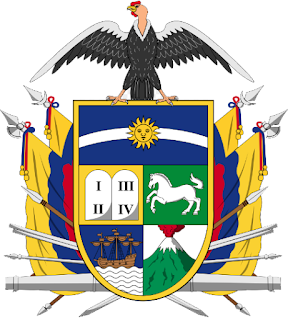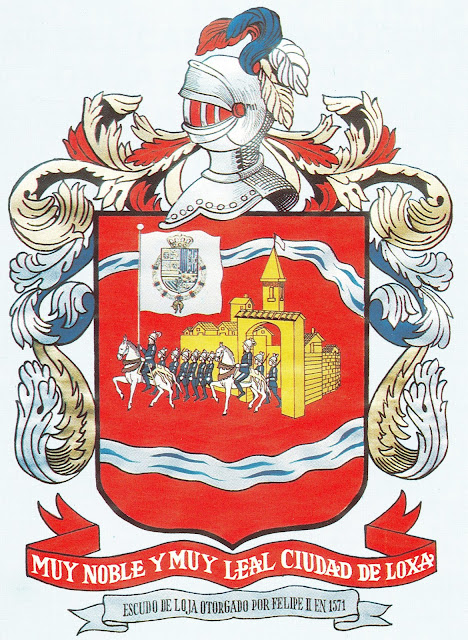Coat of Arms, Shields, Loja and Ecuador Symbolism
 |
| Modern version of the Escudo del Ecuador |
Planted in the center of the flags of both Ecuador and Loja are Coats of Arms (Escudos). Each emblem is loaded with symbols that are pertinent to the history of the country and our city so let's explore each.
 |
| 1830 Escudo |
In 1835 the weapons and cornucopias were dropped (along with the reference to Columbia) and replaced by a scene of mountain peaks and condors. Ecuador had now become a Republic instead of a state.
 |
| 1843 Escudo |
I guess, then, it is not surprising there would be a new Coat of Arms created in 1860. This one really set the stage for the final 1900 version - the two are extremely similar in design so I'll tell you about the 1900 one, which is still the official Escudo del Ecuador of today.
 |
| The elements of Ecuador's national emblem |
In October 31, 1900, the Congress adopted the current escudo. Overall still reigns the mighty condor - symbol of bravery and power, but the shield it now grips contains an imaginary landscape featuring the Chimborazo Volcano, the Guayas River, and the first steamboat (also named Guayas) which has a caduceus (symbolizing peace and protection) for a "mast." Across the sky is the sun, representing the ancestors, set into a zodiac with the four signs Aries, Taurus, Gemini and Cancer to represent the March Revolution of 1845 which lasted four months (March to June).
At the base of the shield is a Roman hacha (axe) and fasces consulares (wood wrapping the axe). This ancient symbol dates to the Etruscans and stands for the authority and dignity of a republican council form of leadership. Within the flags will be seen sprigs of laurel (for glory and triumph) and palm leaves (for peace).
All told, the national emblem for the country of Ecuador has changed six times in 200 years. The Coat of Arms for Loja, however, has basically remained the same for 450 years!
 |
| Escudo del Loja of 1571 |
In 1567, King Felipe II of Spain formally declared our city the "Very Noble and Very Loyal City of Loja." Later, on March 5 of 1571 he granted the city its own Coat of Arms, as shown above.
The included elements symbolize victory with the use of the red color, the rivers Malacatos and Zamora which frame the city, and the soldiers of war who conquered the Amazon with strength and vigilance, who marched under the flag emblazoned with the weapons of the Motherland.
The updated version of this Coat of Arms still retains those basic elements but is more modern in style with the motto "Faithful - Loxa (antique spelling of Loja) - Freedom" at the base of the shield.



Comments
Post a Comment